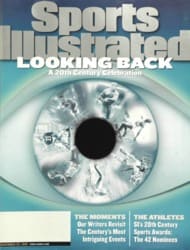
A Bird's-eye View In Beantown THE RED SOX WIN THE WORLD SERIES SEPTEMBER 11 1918
Carrier pigeons were released at the end of each inning, the
birds taking to Camp Devens (thirty miles west of Boston) a
progressive report of the contest....
--THE BOSTON GLOBE Sept. 12, 1918
I stand on the roof of Fenway Park with my flock of faithful
carrier pigeons. The afternoon of Sept. 11, 1918, a Wednesday,
has turned out to be cold in Boston, keeping the crowd down to
15,238 for the sixth and possibly final game of the World Series
between the Red Sox and the Chicago Cubs. I pull up the collar
of my U.S. Army-issued overcoat, stamp my feet, smoke my Sweet
Caporals cigarette and try to keep my service cap from flying
off in the breeze.
The pigeons seem a little nervous. I am a little nervous, too.
"You want to be a sportswriter, Private?" the captain says. "Is
what I hear correct?"
"Yes, it is, sir," I reply.
"Well, this is your chance. Write out a synopsis of every
inning. Tie it to the leg of a pigeon and let the pigeon go.
He'll fly right back to Camp Devens. The troops will know how
the game is going. Lord knows they need something to keep their
minds off the fields of France and the Hun and the mustard gas
and all of it. Do us proud, son."
I am doing the best I can. Given a chance, I think I could write
eloquently about this Series. Maybe not as well as Mr. Ring
Lardner, himself, over there in the press box covering the game
for the Chicago Tribune, but well enough to work for one of the
Boston papers. I have the snappy wisecracks and the metaphors in
my head. I know I do. There isn't much room for creativity,
though, in a message that has to be tied to the leg of a pigeon.
"No score, end of one," I write after the first inning. I send a
bird into the air.
"No score, end of two," I write after the second inning. Another
bird. Gone.
How many pigeons would it take to carry all the lines I could
compose on the wonders of George Herman Ruth, the magnificent
Babe! Twenty-three years old, he not only is the best pitcher in
the game, but he might also be the best hitter! Winner of Games
1 and 4, he extended his Series record to 29 consecutive
scoreless innings pitched before the Cubs finally put a run
across. He hit a triple in Game 4 that was a rifle shot, a fiery
horsehide sphere that went over the head of Chicago rightfielder
Max Flack. (See what I mean about the metaphors?) Is he better
as a pitcher? Is he better as a hitter? The good Lord hasn't
sent us enough birds to carry just the exclamation points that
could be used for either side of that debate!
I could describe the mysteries of righthander Carl (Sub) Mays's
submarine pitch, the elegance of Harry Hooper in rightfield, the
wisdom of manager Ed Barrow in the Boston dugout. I could
unearth the true reasons for the distasteful players' strike
before Game 5 of the Series, the financial shenanigans of major
league officials and team owners that almost ruined the game. I
could tell Mr. and Mrs. America what it is like to be around
this great Boston Red Sox operation--regal, invincible,
dominant--as it stands on the threshold of its third world
championship in four years, a record fifth in the short history
of baseball.
"Red Sox 2, Chicago 0, end of three," I write after the third
inning. I send a bird into the air.
"Red Sox 2, Chicago 1, end of four," I write after the fourth.
Another bird.
I send my pigeons, inning by inning. The score stands. I want to
detail the heroics of George Whiteman. He hit the ball that
ripped through Flack in rightfield for an error that sent home
the only two Boston runs. He also made the play that saved the
game in the eighth, a shoestring catch of a ball hit by Turner
Barber to left--Whiteman running, running, running, snagging the
ball and finishing with a somersault. Who has ever made a better
catch? Who?
"Red Sox 2, Chicago 1, end of eight," I write. Goodbye, bird.
The time is 3:05 when the final out is made: Red Sox 2, Chicago
1. I can see the celebration on the field, the victorious
players gathered near the mound. There's the Babe, right in the
middle of the crowd. People are honking their horns in Kenmore
Square. The scribes in the press box already have begun to type.
I can see the Boston owner, the crafty Harry Frazee, sharing
champagne with friends. There's so much I want to say. I can't
help myself.
"The Red Sox have done it again!" I write with great haste. "No
team will ever approach their accomplishments. They will win
again and again. Boston is--and always will be--the capital of
the baseball world. Raise your children to be Red Sox fans! They
will never be disappointed!"
I have used extra bits of paper to record my message. I roll
them into the tightest of scrolls and attach them to my final
pigeon's leg. I toss the bird into the air. He seems awkward for
a moment but then starts to flap his wings in perfect rhythm.
I watch as he soars higher and higher above the park, above the
noise. He is as strong as the message he carries. Red Sox!
Champions Forever! I can see him above the city now, heading
west, just a dot on the horizon....
Wait a minute.... Did he just seem to pause?... Start to fall?
Must be an optical illusion.
COLOR ILLUSTRATION: ILLUSTRATION BY KADIR NELSON Ruth won two games on the hill and offered a glimpse of his greatness at the plate.
They will win again and again. Boston is--and always will be--the
capital of the baseball world.

